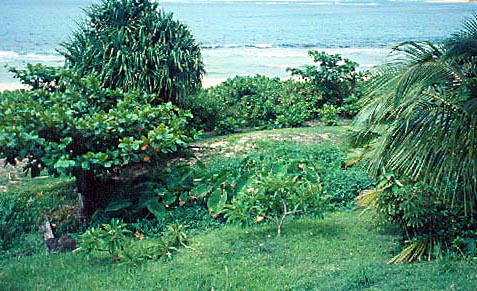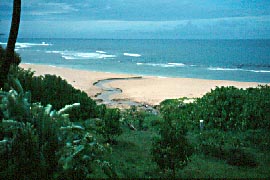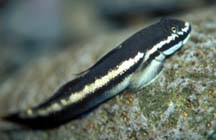 |
 |
 |
|||||
|
|
|
|
|
|
|
|
|
|
|
|||||||
|
|||||||
|
This pool in Limahuli Stream is frequented by beach users.
|
Two perennial streams served Ha‘ena, one each in Limahuli Valley and in Manoa Valley. But while down in the lowlands these streams seem always to be full of water, the upper reaches of the streams can be down to just a trickle, dependent on recent rainfall to feed them. How can this be so? Chipper explains: "One of the things included in the ahupua'a of Ha‘ena, is an area that was probably also a very rarely used resource area, is the hanging valley of Manoa, which is between Wainiha and Limahuli, and is up there perched about 2000 feet up above, there's no access to it other than climbing up these shear cliffs. You have this big mountain with a valley on top of it--a very shallow valley, that has acted as a huge reservoir of water. So this whole mountain fills up with water, and comes out as springs at the base of it. These feed Limahuli and Manoa streams. "So as you go up the valley along Limahuli stream, you see that there is a lot of lo‘i development, because all along the base of the mountain here, we have springs coming out and producing tributaries. The ridge between Ha‘ena and Hanakapi‘ai, however, is a knife-edge ridge, and there's very little spring action because all the water is just running off, it's not being caught."
|
||
|
|
||
|
Taro grows in the little gully where the waters of Wai Kapu spring flow. |
"Limahuli stream is one of the few virtually pristine streams remaining in Hawai‘i, The waterfall falls about 800 feet, from 1600 feet down to 800 feet. It's often not running really hard. Limahuli averages about 5 million gallons a day, and most of that water from that, about 80% of the water, comes from springs that are located along the base of the cliff. "Manoa stream, again, it's basically the same. About 80% of the year, the waterfall is dry, and that stream comes from springs that percolate from the base of the cliff there."
|
||
|
|
||
|
|
There are two better known springs, on located right where the Wichmans live today, between the beach and the pali, near the stone Pohaku-loa. One of these is called Wai Kapu and was said to have been used by the ali‘i at Ha‘ena as their source of fresh water. Chipper says, "That spring used to come out right about where the highway is now, though since they cut the highway it comes out a little bit lower, but you can see it right on the ocean side of the road there, we've got some lo‘i and some taro growing down there."
|
The other is a spring further up on the cliff, called Ka-wai-aloha, "the water of love." Chipper says that the spring of Ka-wai-aloha was one of the rallying cries of Kamehameha when he was rallying his troops to come and conquer Kaua'i. "They wanted to come and eat the anai of Wai-makua, and taste the water of Wai-aloha. And he never got to, poor guy! So this area here is one that was associated with ali‘i and was supposed to have been a kapu area."
|
||
|
|
||
All five species of native Hawaiian freshwater fish, the ‘o‘opu, inhabit Limahuli stream. Samson tells us about catching ‘o‘opu: "My dad always said, ‘o‘opu don't want to say in a stone-walled area in the stream," Samson remembers, "so any small opening on the side, that's where the ‘o‘opu would be. So in those ditches: full... loaded! All the side streams--loaded. We used to put, you know the old kind trunk? We used to bust in the lid, put chicken wire, and go look where there's one good drop, put it right there. Make sure the bottom's in the water. "When the ‘o‘opu fall in, well, we used to pick em up around four o'clock in the afternoon. They drop in, they stay in the trunk. The only thing would get jam up, if somebody going up there, going try catch all these ‘o‘opu, they going throw the trunk out. That's what we used to do."
|
|
"The other thing we used to do when we like ‘o‘opu, if our mother like ‘o‘opu, we block the stream. Take taro-patch stone, wad them with the stone and mud, and with a slap, plug them with the mud and seal them. Just put stone wall and plaster there, and dry them out. Then go pick them up. Half an hour. Just pick up the kind kicking. The ones in the pond, don't even bother with them. Pick up enough, then you go back there and open up the water. Send somebody to open every thing. Whatever you never pick up, you leave them for the next guy. So everybody tell me, "eh, we catch plenty ‘o‘opu!" I don't say nothing. You don't know how this catching ‘o‘opu! "Eat them while they in season. Cause you not gonna get them afterwards. Eat till you filled. Old folks, they like them steamed, or boiled, or lawalu. I like em fried, I like em speed--I just fry them. Ono, though, whenever you eat em, ono--tasty. I put in a bit of salt, and ti leaf. Oh, that aroma is something, that taste!"
|
||
|
|
||
Samson's remarks about cooking ‘o‘opu brings up a proverb and story related by Mary Kawena Pukui:
Click here to read more about ‘o‘opu.
|
||
|
|
||
Eating ‘o‘opu was a seasonal activity, while agriculture provided ongoing sustenance to the Ha‘ena population. Both were dependent on the flow of water. Next is a consideration of planting at Ha‘ena.
|
||
|
|
||
| |
| |
|
|
 |
| Ha'ena Home | Map Library | Site Map | Hawaiian Islands Home | Pacific Worlds Home |

|
|||
| Copyright 2001 Pacific Worlds & Associates • Usage Policy • Webmaster |
|||







